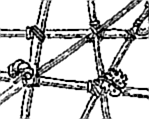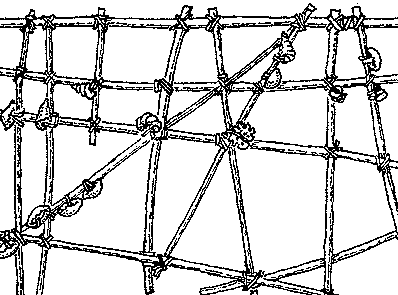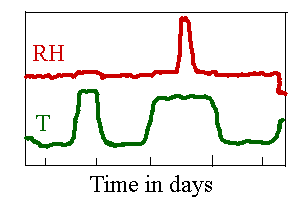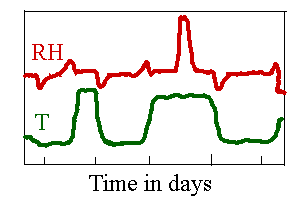
 |
Evidence from thin air |
We sometimes find it expedient to admit the lesser sin to conceal the greater. This was the strategy used by the New Zealand born art courier, Vanilla Klimer. Her greater sin was, however, exposed because of an even worse sin: she did not understand the concept of relative humidity.
The Copenhagen Museum of Far Eastern Art obtained a grant from the European City of Culture '96 fund to organise an exhibition of Pacific marine art and technology. This included the first ever public showing of the famous Woven World Map, a navigation aid made of intertwined twigs with shells attached to show the position of islands and landmarks, which has been interpreted to show that Polynesian outrigger canoes forced the North West Passage (North East passage from their viewpoint) and reached Iceland about the year 400AD, according to C14 dating of one of the twigs and an imaginative interpretation of the interlacing of all the twigs.

The New Zealander who was the discoverer and owner of this unique relic was understandably concerned that a change of relative humidity during transport might cause the twigs, and thus the location of Iceland, to move. The piece was therefore packed, according to the latest theories of art transport, in a polyethylene bag, without humidity buffer but with good thermal insulation in the surrounding rigid case. The bag had a very small hole to allow pressure equalisation during the flight to Copenhagen, which included stopovers in Jakarta and Bombay.
When the package arrived in Copenhagen, the museum curator who was present when the courier opened the package was immediately suspicious. He recognised that the twigs were quite different from those usually used for these sea charts. The courier was terribly upset and broke down in tears, admitting that she had left the package unguarded in her locked hotel room in Bombay, because it was so hot and steamy that she had to sleep on the balcony just outside. When she woke up unexpectedly and heard a noise in the room she rushed to investigate. The lock had been forced but she could not see that the packet had been disturbed. She had reported the incident to the hotel management and to the insurance company. She moaned miserably over her irresponsibility in not checking the packet more carefully. Then she rushed over to the transport case and pulled at the polyethylene bag. Finally she emerged with a small box: the climate data logger. "This will show if the case was opened", she said. Then with surprising presence of mind she continued: "You'd better get its data read by an independent witness".
Thus it was that I entered the case, as a specialist in extracting data from the innumerable species of micro datologger that have suddenly begun to emerge from the cellars and garages of young electronic engineers who snap a sensor onto one of these programmable microcomputer chips that are made in California and Oregon and sell them to museums, together with hopelessly eccentric graphing programs that no one can get to work. This one was a 'Flitesensa' (TM) and the graph looked like this:

The graph showed the rise in temperature during the stops in Jakarta and Bombay but the RH remained stable, except in Bombay where a sudden rise coincided with Vanilla's disturbed night, apparently confirming that the case had been opened in the humid tropical night. At this moment a superficially similar fake could have been substituted.
I, however, was disturbed by the lack of disturbances at other times. The stability was unnaturally good. I would have expected something like the graph below:

The RH will fall when the aircraft takes off, because air moves out of the bag. The ratio of water molecules to air molecules in the bag is unchanged but the concentration of water vapour around the object, expressed as grams per unit of volume, will decrease. This is the same as saying that the water vapour pressure has decreased. Remember that the RH is defined as the actual water vapour pressure expressed as a percentage of the saturation vapour pressure. Notice that air does not appear in the definition. We loosely talk about the relative humidity of air, but we really mean the relative humidity of space. This distinction is just pedantic at ground level but frequent flyers with art in their laps would be advised to remember it.
Correspondingly, the RH will rise as the aircraft descends and air moves into the bag. Some of this air may be dry, high altitude air, but it still contains some water vapour, so the total water vapour per unit volume increases around the object and the RH rises.
These changes of RH will quickly be compensated by release or absorption of water vapour by the twigs, but modern aircraft climb quickly and the effect is usually noticeable.
Such evidence would, however, be too uncertain alone, so I wrote my report to the curator, with a copy to the insurance company, and added that identification of the twig species might shed further light on the affair.
The tree turned out to be a mountain conifer from North America. This species was imported into New Zealand early in this century. Suspicion therefore turned on the owner of the famous relic. He had published a detailed description and drawing (part of the 1 metre square drawing is shown above), but the actual object had never been exhibited before and had only briefly been shown to reporters. Scholars had never succeeded in getting more than a brief look at it in the dim light of the owner's home, because of its supposed great sensitivity to relative humidity, a reason that is enormously respected by museum scholars and conservators but not by all scientists, I have heard.
The botanical evidence, combined with the probability that the datalogger had been programmed with a false date, exposed to varying temperature and relative humidity at ground level and finally planted in the opened package by the distraught courier, was sufficient for the insurance company to repudiate the claim for a hundred thousand dollars for the loss of priceless historic evidence.
I returned the datalogger to Vanilla, reprogrammed and accompanied by a card suggesting that she read the data when she landed in New Zealand. Both items were enclosed in a plastic bag with a small hole.

This work is licensed under a Creative Commons Attribution-Noncommercial-No Derivative Works 3.0 License.